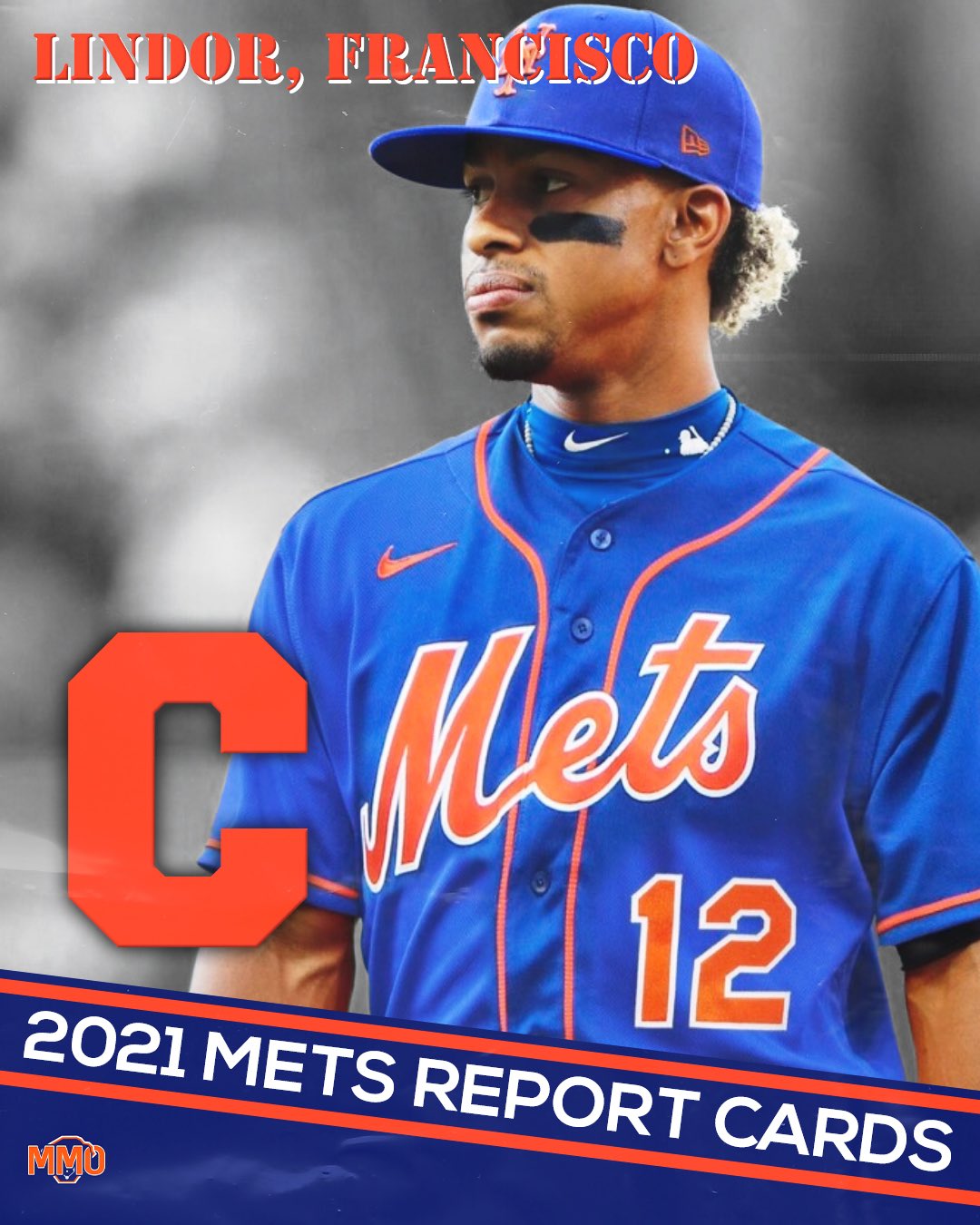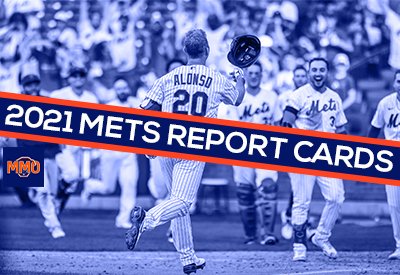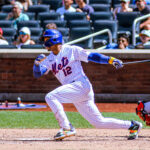
Player Data: Age: 27 (11/14/1993), B/T: S/R
Primary Stats: 125 G, 524 PA, .230 BA, .322 OBP, .412 SLG, .734 OPS, 104 H, 20 HR, 63 RBI, 58 BB, 96 SO
Advanced Stats: 103 wRC+, 18.3% K%, 11.1% BB%, .248 BABIP, .341 xwOBA, 2.7 fWAR, 3.1 bWAR
2021 Salary: $22.3 million
Grade: C
2021 Review
On January 7, the New York Mets acquired Francisco Lindor from Cleveland. The trade was the first franchise-changing move made under Steve Cohen and signaled the beginning of a new era of Mets baseball. Unfortunately for Lindor and the Mets, his first season in Queens left more to be desired.
When Lindor arrived, expectations were incredibly high. In his six seasons in the Majors with Cleveland, Lindor had a triple slash line of .285/.346/.488 while being baseball’s premier defensive shortstop. After hitting .365/.431/.615 in his first Spring Training as a Met, he agreed to a 10-year, $341 million contract extension prior to Opening Day to remain with the Mets for the next 11 years (including his last year of arbitration). After a delayed start to the season due to a COVID breakout for the Washington Nationals, Lindor struggled to turn that spring success into regular season success.
Lindor’s tenure as a Met could not have gotten off to a worse start. April was the worst full month of his career. He had 14 hits and just two extra base hits over 77 at-bats, and he produced just a .182/.297/.234 triple slash line. His first home run as a Met and only home run in April came on April 21 at Wrigley Field. May was arguably the second worst month of Lindor’s career. Although his numbers did improve from April, they were not considerably better. He hit .204/.292/.344 with three home runs and four doubles over 93 at bats.
With injuries piling up early and often for the Mets, it was clear that Lindor was pressing to make up for the loss of production on the injured list. He looked to be selling out to drive the ball to the pull side, but he wasn’t able to get his timing right. On what felt like nearly a nightly basis, Lindor was making his best contact on balls that he pulled foul. Even though his strikeout rate remained low as it has been for his entire career, he was pulling fastballs foul while rolling over breaking balls and making weak contact on balls that he put in play. When a pitcher made a mistake, it felt like it would result in a loud foul ball more often than not since he was constantly hitting the ball out in front of the plate.
When June came around, the Mets’ shortstop started to show signs of life. Lindor had hits in each of his last three games in May with multi-hit performances in the final two. He started June with hits in five straight and added three more multi-hit games during that stretch.
On June 19 in Washington, Mets fans finally got to see the Lindor that can take over a game. He went 3-for-4 with two home runs and drove in all five runs in a 5-1 win. Fans who followed Lindor’s time in Cleveland had become accustomed to performances like this from the star shortstop, but seeing him finally have a breakout game for the Mets was an encouraging sign that we may be getting closer to seeing Lindor at his best. He finished the month hitting .241/.311/.454 with five home runs and 12 extra-base hits over 108 at bats.
Early in July, it looked like it was going to be Lindor’s breakout month. He started the month with a strong series in Yankee Stadium that saw him have back-to-back multi-hit games before getting hits in both of his starts in Milwaukee. The Mets closed out the first half with a four game series against the Pittsburgh Pirates. Lindor went 5-13 in the series with two home runs and had hits in three of the four games. In his first game of the second half, Lindor would go 1-3 before going down with a right oblique strain. After going 12-36 with a .333/.489/.500 triple slash line, Lindor missed the rest of the month and didn’t return until August 24. It was the just the second time in his career that he was placed on the injured list.
When Lindor returned, he had Javier Báez playing next to him at second base. The childhood friends were vocal about how they felt they benefitted playing along side each other. Lindor opted to forego a rehab assignment and came right back to the Major League team when he was healthy. He struggled in his first week, but once he got back into the swing of things, he showed again that he can be a game changing talent when the calendar turned to September.
In each of his last three full seasons, Lindor hit at least 32 home runs. He hit just 11 home runs entering the season’s final month, but he put on a power display and proved that pop was still there. His signature game as Met came on September 12 against the Yankees. Lindor hit three home runs in the game, and was at the center of two confrontations. After hitting his second home run of the game, Lindor made a whistling gesture towards Gleyber Torres after he thought the Yankees were stealing signs. Giancarlo Stanton yelled back at Lindor when he tied the game with a home run of his own which led to benches clearing. With all eyes on Lindor when he came up in the bottom of the eighth, Lindor hit a no-doubt go-ahead shot into the Coca-Cola Corner and flexed as he rounded first base. He finished September hitting .267/.359/.574 with nine home runs and 25 RBIs.
.@Lindor12BC was charged up for the #SubwaySeries! 🔋 #CarryThe Freight pic.twitter.com/ueiH5bEiqM
— New York Mets (@Mets) September 13, 2021
The bat may not have been up to the standard Lindor has set for himself, but his glove was just as good as advertised. Lindor finished second in all of baseball in Outs Above Average, per Statcast, and was named a Gold Glove finalist. He certainly made his fair share of highlight-reel plays, but what stood out about Lindor’s defense was his ability to make the difficult plays look routine. Unlike what we had seen from Mets’ shortstops in recent years, Lindor played much deeper at shortstop than most. The extra time to get to balls he gained by playing deep coupled with his ability to charge on balls is what makes Lindor such a dependable glove at shortstop.
While the Mets saw plenty of the shortstop they envisioned they were getting when they acquired Lindor from Cleveland, the dreadful first two months coupled with the 36-day stint on the IL led to the worst overall season of his career. Despite playing like the player he has always been for a majority of the season, he was not able to make his overall numbers look close to his standards by season’s end. Plenty went wrong for the Mets in 2021, but it is hard to not wonder how the season could have played out if Lindor provided his typical level of production.
“I feel like we had a really good team coming into this year,” Lindor told the Daily News‘ Deesha Thosar on September 22. “If I had played a little bit better, I know we could’ve won at least 5-7 more games, then we would’ve been fighting for first place right now.”
The Mets led the NL East for a large chunk of the season, and with the Atlanta Braves completing their improbable run to a World Series title, it is fair to wonder how things would have played out if the Mets could have held on to their division lead.
2022 Outlook
While the overall numbers for Lindor in 2021 were a major disappointment, there is plenty of reason to believe that his struggles were due to joining a new team in a new league.
Lindor looked like the $341 million shortstop we were expecting from May through the end of the season. His first year in Queens ended up being extremely similar to another Puerto Rican star’s first season as a Met, Carlos Beltran. Beltran struggled in his first year as a Met in 2005, but unlike Lindor, he was never able to get any sort of hot streak going. In 2006, Beltran had an 8.2 bWAR and finished fourth in NL MVP voting. Unlike Beltran in 2005, Lindor showed signs of being the player the Mets committed big money to. Lindor received MVP votes every year from 2016-2019. If he finishes 2022 with MVP votes, it should not come as a surprise.
















